Summary of the books
The books contain reviews by structural engineers of post disaster designs that have been built in significant numbers. It is intended that this information will support the early stages of shelter programmes and inform shelter decision making. These shelters should not be used without being adapted to the context. Inclusion of shelter designs does not mean that they have been endorsed by IFRC.
The books contain post disaster shelters that are not intended as complete permanent housing units. Some “core houses” are included. These core houses are intended to be permanent but are small in size and are designed to be extended.
The books are structured as follows:
- Section A discusses shelter design briefs, includes a programming checklist and explains how the shelters were reviewed.
- Section B contains summary findings of the technical reviews for the shelters.
-
Annexes contain details of materials, a template design brief, conversion tables, a glossary, and references.
These books are not guidelines on shelter programming. They reference external guidance wherever possible, and do not focus on other aspects of the shelter programmes from which the designs came.
These two books are primarily aimed at shelter delegates within the Red Cross and Red Crescent movement. They are also intended to inform those planning and managing shelter programmes.
IFRC shelter working group
These webpages are to share the outputs of the IFRC technical shelter working group relating to the design of shelters.
There are now two editions of this book. Both editions were compiled and edited by Joseph Ashmore and Corinne Treherne (IFRC).
The Engineering assessments in the second edition were conducted free of charge by AMEC in partnership with IFRC.
The Engineering assessments in The first edition were conducted by project consultants ARUP International Department.
This book was the output of the Transitional shelter Task Group of the Red Cross and Red Crescent. It is based on the projects and contributions from the following national societies:
American Red CrossBelgium Red CrossFinish Red CrossItalian Red CrossLuxembourg red CrossPalang Merah IndonesiaPakistani Red CrescentVietnam Red Cross |
Australian Red CrossBritish Red CrossFrench Red CrossMyanmar Red CrossPeru Red CrossSwedish Red CrossRwanda Red Cross |
Bangladesh Red CrescentCanadian Red CrossGerman Red CrossNetherlands Red CrossQatar Red CrescentSwiss Red CrossSpanish Red Cross |
With additional contributions from NRC (Norwegian Refugee council), CRS (Catholic Relief services) and HI (handicap international)


